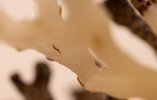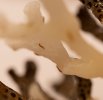I'll address a couple of the comments at once. Thanks for the suggestions and observations, truly appreciated. I haven't calibrated my refractometer, but I do have calibration liquid and I will check it. My salt is mixed in 30 gallon batches and is used for both my display and frag tank. For the amount of salt I'm adding it seems accurate, but verification is everything in this hobby. I'm only having this die off in the frag tank. Parameter wise, I have been bouncing off the bottom for phosphates and low nitrates as well. However, in my old tank some of these same corals survived for a year in a zero'd out environment with dinos and pale as can be. When I moved them to the new tank with nutrients they turned around very quickly Most of these also survived my crazy alk swing I posted about last summer. I would think that if it were parameter related I would lose a couple at once. It's never more than one at a time. There are things I could do better. I'm still manually dosing, still have a GHL mini and a calcium reactor offline for no good reason. My parameter swings aren't very large, ALK is typically about 7.2, with no more than a 0.5 swing between doses for both tanks. I will check everything again. I feed fairly heavy because of the breeding clown pair. I'm taking next week off from work, so I'll be trying to get things more automated for both tanks. With Covid cases continuing to drop, I may be traveling again in the near future.
Lighting: My par is 100 on the bottom, 150-180 where my SPS are. My LED is a single Mitras tuned to the Coral AB spectrum by me. I measured ActiveAngel's Radions with a Spectral Radiometer. It's in an Aquatic Life Hybrid T5 setup. 2 blue plus, 1 coral plus, 1 actinic. I haven't touched the lighting or schedule since I setup this tank.
I dip Bayer, Revive, and then iodine before corals go into the QT. Still, I got some Interceptor to try it in case something got past them. I have to say that for one coral, a bottlebrush, it appeared to stop the STN and the polyp extension came back, but no obvious pests laying on the bottom afterwards. For two others it did nothing and they died within hours. I moved on to Furan-2 thinking bacterial also and I had some zoas that could use a treatment anyway. If was my first experience with dosing an antibiotic and I basically nuked my coral QT frag tank with the stuff. I followed the directions, but everything went super pale after 36 hours. It's supposed to be a 4 day treatment, I stopped after 3 and did a 80% water change, it's been a slow recovery.
I could have a flow issue. All these frags have grown 3-4 times what they were a few months ago. I've added one of the MP10's I have, but I've been lazy about adding the second one as I need to get around to repairing an extension cable and getting the MP10 moved into my accessories cabinet. I'm planning a layout change to split my frag racks in half and move my rock structure to get the SPS in the middle of the tank for peak lighting and ensure that there is an MP10 on either side set to reef mode to really move the water around.
I have ordered ATI ICP kits ,thanks
@Adam for the suggestion, and I have been curious about the Aquabiomics bacterial analysis for about a year, so that is coming too. Of course BRS did a video on them the day I decided to order and backlogged the kits, so we will see when I can get the results.






